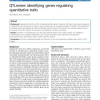11397 search results - page 2167 / 2280 » A Relational Abstraction for Functions |
BMCBI
2010
14 years 10 months ago
2010
Background: A growing demand for tools to assist the building and analysis of biological networks exists in systems biology. We argue that the use of a formal approach is relevant...
BMCBI
2007
14 years 10 months ago
2007
Background: The genomic revolution has led to rapid growth in sequencing of genes and proteins, and attention is now turning to the function of the encoded proteins. In this respe...
BMCBI
2010
14 years 10 months ago
2010
Background: Quantitative trait locus (QTL) mapping identifies genomic regions that likely contain genes regulating a quantitative trait. However, QTL regions may encompass tens to...
BMCBI
2008
14 years 10 months ago
2008
Background: Expression profiles obtained from multiple perturbation experiments are increasingly used to reconstruct transcriptional regulatory networks, from well studied, simple...
BMCBI
2008
14 years 10 months ago
2008
Background: Amino acid sequence probability distributions, or profiles, have been used successfully to predict secondary structure and local structure in proteins. Profile models ...

